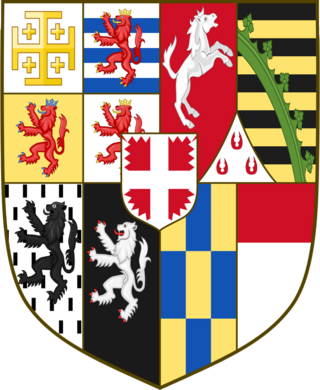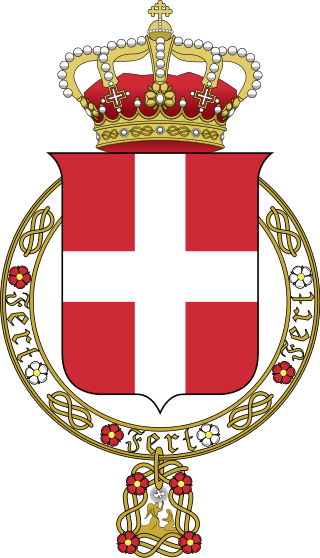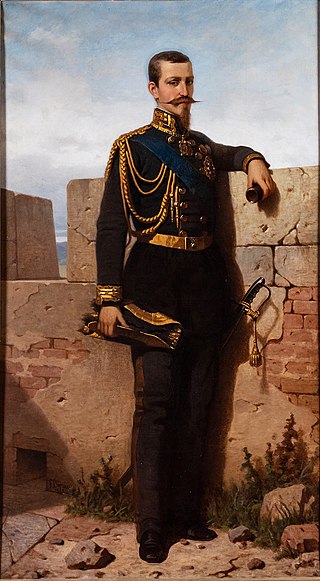Carignano may refer to:

The House of Savoy-Carignano originated as a cadet branch of the House of Savoy. It was founded by Thomas Francis, Prince of Carignano (1596–1656), an Italian military commander who was the fifth son of Charles Emmanuel I, Duke of Savoy. His descendants were accepted as princes étrangers at the court of France, where some held prominent positions. Upon the extinction of the main Savoy line they eventually came to reign as kings of Sardinia from 1831 to 1861, and as kings of Italy from 1861 until the dynasty's deposition in 1946. The Savoy-Carignano family also, briefly, supplied a king each to Spain and Croatia, as well as queens consort to Bulgaria and Portugal.

The House of Savoy is an Italian royal house that was established in 1003 in the historical Savoy region. Through gradual expansions the family grew in power, first ruling a small Alpine county northwest of Italy and later gaining absolute rule of the Kingdom of Sicily. During the years 1713 to 1720, they were handed the island of Sardinia and would exercise direct rule from then onward.
Emmanuel Philibert of Savoy, a name shared by several members of the House of Savoy, may refer to:
Carignan is a Spanish variety of grape.

The Residences of the Royal House of Savoy are a group of buildings in Turin and the Metropolitan City of Turin, in Piedmont. It was added to the UNESCO World Heritage Sites list in 1997.

Prince Ferdinando of Savoy, 1st Duke of Genoa was the founder of the Genoa branch of the House of Savoy.

The March or Marquisate of Turin was a territory of medieval Italy from the mid-10th century, when it was established as the Arduinic March. It comprised several counties in Piedmont, including the counties of Turin, Auriate, Albenga and, probably, Ventimiglia. The confines of the march thus stretched across the Po Valley from the Western Alps in the north, to the Ligurian Sea.

Palazzo Carignano is a historical building in the centre of Turin, Italy, which houses the Museum of the Risorgimento. It was a private residence of the Princes of Carignano, after whom it is named. Its rounded façade is different from other façades of the same structure. It is located on the Via Accademia delle Scienze.
The Princess of Carignano was a woman married to the Prince of Carignano of the House of Savoy. The list ends with Charles Albert, in 1831, after he became King of Sardinia. But the Queens of Sardinia and later Italy used the title "Princess of Carignano" as part of their full title which included a lot of other titles.

The Savoy Gallery is an art collection in the Italian city of Turin, which contains the royal art collections amassed by the House of Savoy over the centuries. It is located on Via XX Settembre, 86.

Charles Emmanuel of Savoy, 6th Prince of Carignano was a Prince of Savoy and later the Prince of Carignano between 1780 and 1800, and the paternal grandfather of Vittorio Emanuele II, the first king of a united Italy.
Genoa is a city in Italy.
Savoyard refers to:

Princess Christine of Hesse-Rheinfels-Rotenburg was a princess of the German dynasty of Hesse-Rheinfels-Rotenburg. She was the Princess of Carignano by marriage and mother of the princesse de Lamballe and of Victor Amadeus II, Prince of Carignan.

Louis Victor of Savoy, 4th Prince of Carignano headed a cadet branch of the Italian dynasty which reigned over the Kingdom of Sardinia, being known as the Prince of Carignano from 1741 till his death. Upon extinction of the senior line of the family, his great-grandson succeeded to the royal throne as King Charles Albert of Sardinia, while his great-great-grandson, Victor Emmanuel II, became King of Italy.

Eugenio of Savoy was a prince of the House of Savoy and founder of the Villafranca branch of the royal family of Italy that survived until 1888. He was a brother of Queen Marie Antoinette's tragic confidante, the Princesse de Lamballe.

Princess Leopoldina of Savoy was a Princess of Savoy and later the Princess of Melfi, as wife of Giovanni Andrea VI Doria-Pamphilj-Landi, (13) Prince of Melfi. She was the older sister of the princesse de Lamballe.
San Colombano is the Italian form of Saint Columbanus.
Treaty of Turin can refer to one of the following treaties signed in the northern Italian town of Turin:
Principe di Carignano may refer to: